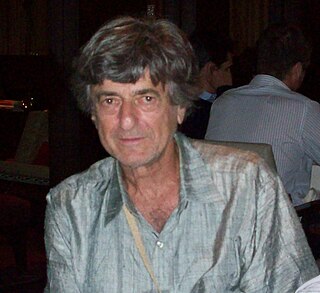
Algebraic geometry is a branch of mathematics which uses abstract algebraic techniques, mainly from commutative algebra, to solve geometrical problems. Classically, it studies zeros of multivariate polynomials; the modern approach generalizes this in a few different aspects.
In commutative algebra and algebraic geometry, elimination theory is the classical name for algorithmic approaches to eliminating some variables between polynomials of several variables, in order to solve systems of polynomial equations.

Theoretical computer science is a subfield of computer science and mathematics that focuses on the abstract and mathematical foundations of computation.
In computational complexity theory, P, also known as PTIME or DTIME(nO(1)), is a fundamental complexity class. It contains all decision problems that can be solved by a deterministic Turing machine using a polynomial amount of computation time, or polynomial time.
In mathematics, a real closed field is a field F that has the same first-order properties as the field of real numbers. Some examples are the field of real numbers, the field of real algebraic numbers, and the field of hyperreal numbers.
Algorithmic topology, or computational topology, is a subfield of topology with an overlap with areas of computer science, in particular, computational geometry and computational complexity theory.
In mathematics, real algebraic geometry is the sub-branch of algebraic geometry studying real algebraic sets, i.e. real-number solutions to algebraic equations with real-number coefficients, and mappings between them.
Information-based complexity (IBC) studies optimal algorithms and computational complexity for the continuous problems that arise in physical science, economics, engineering, and mathematical finance. IBC has studied such continuous problems as path integration, partial differential equations, systems of ordinary differential equations, nonlinear equations, integral equations, fixed points, and very-high-dimensional integration. All these problems involve functions of a real or complex variable. Since one can never obtain a closed-form solution to the problems of interest one has to settle for a numerical solution. Since a function of a real or complex variable cannot be entered into a digital computer, the solution of continuous problems involves partial information. To give a simple illustration, in the numerical approximation of an integral, only samples of the integrand at a finite number of points are available. In the numerical solution of partial differential equations the functions specifying the boundary conditions and the coefficients of the differential operator can only be sampled. Furthermore, this partial information can be expensive to obtain. Finally the information is often contaminated by noise.
Smale's problems is a list of eighteen unsolved problems in mathematics proposed by Steve Smale in 1998 and republished in 1999. Smale composed this list in reply to a request from Vladimir Arnold, then vice-president of the International Mathematical Union, who asked several mathematicians to propose a list of problems for the 21st century. Arnold's inspiration came from the list of Hilbert's problems that had been published at the beginning of the 20th century.
In mathematics, cylindrical algebraic decomposition (CAD) is a notion, along with an algorithm to compute it, that is fundamental for computer algebra and real algebraic geometry. Given a set S of polynomials in Rn, a cylindrical algebraic decomposition is a decomposition of Rn into connected semialgebraic sets called cells, on which each polynomial has constant sign, either +, − or 0. To be cylindrical, this decomposition must satisfy the following condition: If 1 ≤ k < n and π is the projection from Rn onto Rn−k consisting in removing the last k coordinates, then for every pair of cells c and d, one has either π(c) = π(d) or π(c) ∩ π(d) = ∅. This implies that the images by π of the cells define a cylindrical decomposition of Rn−k.
In computational complexity theory, and more specifically in the analysis of algorithms with integer data, the transdichotomous model is a variation of the random-access machine in which the machine word size is assumed to match the problem size. The model was proposed by Michael Fredman and Dan Willard, who chose its name "because the dichotomy between the machine model and the problem size is crossed in a reasonable manner."
In mathematical logic, computational complexity theory, and computer science, the existential theory of the reals is the set of all true sentences of the form where the variables are interpreted as having real number values, and where is a quantifier-free formula involving equalities and inequalities of real polynomials. A sentence of this form is true if it is possible to find values for all of the variables that, when substituted into formula , make it become true.

In mathematical optimization, the criss-cross algorithm is any of a family of algorithms for linear programming. Variants of the criss-cross algorithm also solve more general problems with linear inequality constraints and nonlinear objective functions; there are criss-cross algorithms for linear-fractional programming problems, quadratic-programming problems, and linear complementarity problems.

Richard M. Pollack was an American geometer who spent most of his career at the Courant Institute of Mathematical Sciences at New York University, where he was Professor Emeritus until his death.

Michael Ira Shub is an American mathematician who has done research into dynamical systems and the complexity of real number algorithms.

Anatol Slissenko is a Soviet, Russian and French mathematician and computer scientist. Among his research interests one finds automatic theorem proving, recursive analysis, computational complexity, algorithmics, graph grammars, verification, computer algebra, entropy and probabilistic models related to computer science.
Ferdinando 'Teo' Mora is an Italian mathematician, and since 1990 until 2019 a professor of algebra at the University of Genoa.

Joris van der Hoeven is a Dutch mathematician and computer scientist, specializing in algebraic analysis and computer algebra. He is the primary developer of GNU TeXmacs.
James Milton Renegar Jr. is an American mathematician, specializing in optimization algorithms for linear programming and nonlinear programming.
Deepak Kapur is a Distinguished Professor in the Department of Computer Science at the University of New Mexico.







